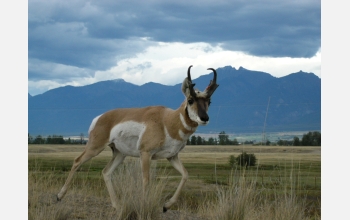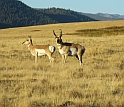News Release 06-152
Female Pronghorns Choose Mate Based on Substance as Well as Show
Offspring of vigorous males more likely to survive

Female pronghorns select mates like this buck, through means other than male ornamentation.
October 23, 2006
This material is available primarily for archival purposes. Telephone numbers or other contact information may be out of date; please see current contact information at media contacts.
When a female animal compares males to choose a mate, she can't order a laboratory genetic screen for each suitor. Instead, she has to rely on external cues that may indicate genetic quality. Until now, biologists have focused on elaborate ornaments, such as the peacock's tail, as cues that females might use.
The thorny problem has been to explain how the correlation between male genetic quality and ornament quality can be maintained. If an ornament gives a male a mating advantage, then evolution would rapidly move to the point where all males, regardless of genetic quality, have high-quality ornaments.
"Female mate choice is likely a very important evolutionary force that does much more than select for ornaments in a few species," said John Byers of the University of Idaho. "It may be universally important in maintaining population genetic quality."
In work supported by the National Science Foundation (NSF), Byers has shown that certain females can choose good genes in a species that does not have ornaments, such as the American pronghorn, an antelope-like mammal that evolved in North America. Byers has been studying pronghorn at the National Bison Range, a 30-square-mile National Wildlife Refuge in northwestern Montana, for 20 years, and recognizes all individual pronghorn in the population.
In recent research, Byers and his coauthor Lisette Waits, also of the University of Idaho, obtained genetic markers for all pronghorn individuals in the population and assigned paternity to the offspring.
"The females' mate sampling creates a small group of males that each year sire more than one-half of all young," said Byers, who is currently serving as a program officer in NSF's biological sciences directorate. "These are the males that, under the stringent female sampling process, have shown they are the most vigorous."
The offspring of these vigorous males also are more likely to survive to weaning, Byers found. "This advantage is due to faster growth rates," he said.
Byers also showed that these faster-growing fawns suckle less from their mothers than do the offspring sired by less-attractive males. He monitored the population for several years, and found the offspring of frequently chosen males continued to have a survival advantage for as long as five years.
The research results appear in this week's issue of the Proceedings of the National Academy of Sciences (PNAS).
-NSF-
-
Biologists study antelope courtship at Montana's National Bison Range.
Credit and Larger Version
Media Contacts
Cheryl Dybas, NSF, (703) 292-7734, email: cdybas@nsf.gov
The U.S. National Science Foundation propels the nation forward by advancing fundamental research in all fields of science and engineering. NSF supports research and people by providing facilities, instruments and funding to support their ingenuity and sustain the U.S. as a global leader in research and innovation. With a fiscal year 2023 budget of $9.5 billion, NSF funds reach all 50 states through grants to nearly 2,000 colleges, universities and institutions. Each year, NSF receives more than 40,000 competitive proposals and makes about 11,000 new awards. Those awards include support for cooperative research with industry, Arctic and Antarctic research and operations, and U.S. participation in international scientific efforts.
Connect with us online
NSF website: nsf.gov
NSF News: nsf.gov/news
For News Media: nsf.gov/news/newsroom
Statistics: nsf.gov/statistics/
Awards database: nsf.gov/awardsearch/
Follow us on social
Twitter: twitter.com/NSF
Facebook: facebook.com/US.NSF
Instagram: instagram.com/nsfgov



